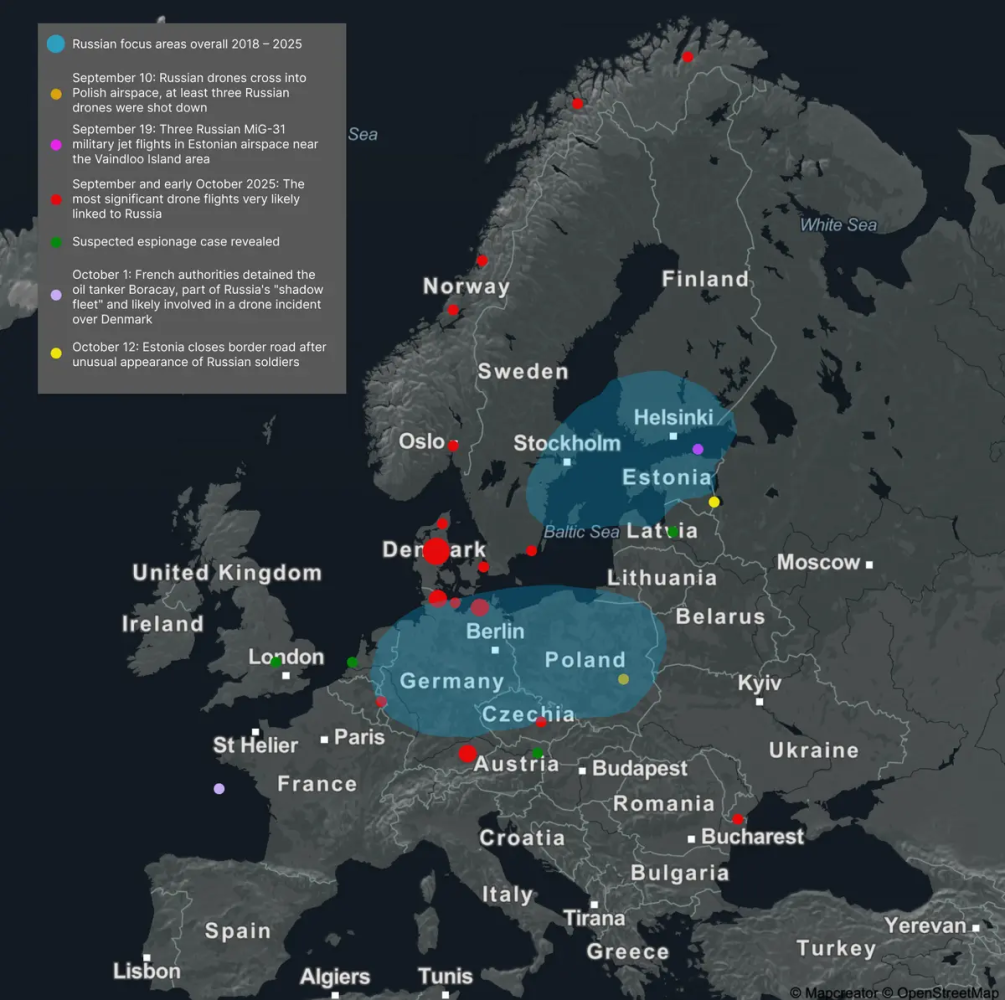Moscow is pursuing a campaign of unconventional aggression aimed at destabilizing Europe. Through actions such as sabotage, vandalism, and espionage, Russia seeks to weaken European governments, erode popular backing for Ukraine by creating societal and economic hardships, and ultimately aiming to hinder the unified response, especially of NATO but also the European Union. Although Russia has so far been unsuccessful in accomplishing its primary goal, European nations have had difficulty responding to its sabotage campaigns. Specifically, they have struggled to coordinate a unified response and impose meaningful consequences on Moscow. Overall, for businesses, Russia's increasing hybrid warfare is making the operating environment in Europe less stable and more complex.
Recent developments: September and early October 2025
In September and early October 2025, the Russian Federation is executing a coordinated escalation of its hybrid warfare campaign against Europe. During that time frame, military posturing included the Zapad-2025 exercise to further integrate Belarus armed forces to Russian force structure, a series of airspace violations, and a drone incursion into Poland on September 10, marking the first direct NATO-Russia engagement since 2022. Concurrently, Russia and linked actors are very likely behind a widespread drone campaign causing disruption at major civilian airports. This is accompanied by a sustained electronic warfare campaign; for example, GNSS interference incidents in Swedish airspace jumped from 55 in 2023 to 733 by early September 2025.

Outlook for upcoming 6 months
Over the next six months Russia will very likely continue intelligence operations, distinctly focusing on the maritime approaches to the Baltic Sea and other critical targets associated with a potential NATO confrontation.
A consistent pattern of drone reconnaissance, originating near the Kola Peninsula, tracking Norway’s coastline, and intensifying over the Danish Straits and proximate German and Swedish naval facilities, is likely geared towards developing operational solutions for reinforcing its Baltic Sea Fleet from the Northern Fleet in a contested environment – if needed. This represents an effort to solve a specific military problem related to NATO's control of these chokepoints.
This intelligence gathering occurs as Russia intensifies efforts to secure a favorable conclusion to the war in Ukraine. However, Russia will not agree to end the war in Ukraine unless the terms are beneficial to its interests. A success, or even a pause in Ukraine would release conventional forces, enabling a more assertive posture towards NATO.
Consequently, while the disruption of supply chains supporting Ukraine remains a possible or even likely course of action within upcoming six months, we must consider the broader implications. A kinetic probing action designed to test NATO's Article 5 cohesion represents a low-probability but high-impact scenario that cannot be entirely ruled out within this forecast period, though it remains a greater risk in the longer term. Even though very unlikely as of now, an example of this type of action could be the capture of the Suwalki Gap, which would allow Russia to connect Kaliningrad to Belarus.
From the business point of view, this outlook, like the previous one, signals a heightened risk of disruption to European business environment and its supply chains.
Analyzing strategic intent
Analysis of Russian military and hybrid activity necessitates a framework that looks beyond observable actions to discern underlying strategic intent. We must operate from the premise that any pattern right now is likely indicative of efforts to solve a specific operational problem tied to a broader objective. Russia's strategic calculus is driven by the perception of an existential conflict with the West for its position in a developing multipolar world order. This worldview results in a risk appetite that is substantially higher than that of Western states. Consequently, assessing the viability of a potential Russian conflict with NATO requires identifying and monitoring the critical military prerequisites Russia would need to secure beforehand. For example, the capability to reinforce its Baltic Sea Fleet is important enabler for any sustained operation in that theater.